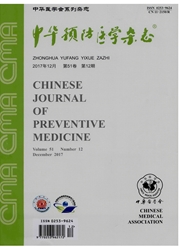

 中文摘要:
中文摘要:
目的 探讨超重肥胖与青少年青春发动时相提前和延迟的关联及性别差异.方法 于2014年10—12月,在沈阳市沈北新区、北京市延庆区、郑州市二七区和重庆市九龙坡区采用立意抽样,选取二、三、初一、初二年级女生,三、四、初一、初二年级男生为调查对象.收集人口学特征,采用青春发育量表评价青春期发育.共调查了6701名中学生,收回有效问卷6137份.采用多项式logistic回归模型分析超重肥胖与男女生青春期发育的关联.结果 小学男女生超重肥胖检出率分别为34.8%(522/1499)、24.2%(341/1409),中学男女生超重肥胖的检出率分别为31.3%(591/1658)、21.8%(342/1571).小学男女生青春发育提前检出率分别为15.0%(225/1499)和14.2%(200/1409),中学男女生青春发育延迟检出率分别为14.3%(237/1658)和14.9%(234/1571).调整地区、年龄、是否独生子女、家庭经济状况和父母文化程度后,与正常体重相比,小学女生超重肥胖与青春发育提前呈正向关联(OR=2.16,95%CI:1.56~2.99),中学女生超重肥胖与青春发育延迟呈负向关联(OR=0.54,95%CI:0.36~0.80),P值均〈0.05.与正常体重相比,小学和中学男生超重肥胖与青春发动时相关联均无统计学意义,OR(95%CI)值分别为1.08(0.80~1.45)和0.93(0.69~1.27)(P值均〉0.05).结论 小学女生超重肥胖与青春发育提前呈正向关联,中学女生超重肥胖与青春发育延迟呈负向关联;但在男生中并未发现这种关联.
 英文摘要:
英文摘要:
Objective To understand the associations between overweight-obesity and puberty timing in children with different genders. Methods The girls in grade 2, 3, 7, 8 and boys in grade 3, 4, 7, 8 were recruited from primary and middle schools in North new area of Shenyang, Yanqing district of Beijing, Erqi district of Zhengzhou and Jiulongpo district of Chongqing by purposive sampling method between October and December 2014, respectively. The information of demographic characteristics of the respondents were collected and the pubertal development status was evaluated by Pubertal Development Scale (PDS). A total of 6701 students were recruited; 6137 out of which were valid with complete questionnaires. The associations between overweight-obesity and puberty timing were estimated by multivariate logistic regression analysis. Results The prevalence of overweight-obesity in primary schools were 34.8% (522/1499) among boys and 24.2% (341/1409) among girls, respectively. The prevalence of overweight-obesity in middle schools were 31.3% (591/1658) among boys and 21.8% (342/1571) among girls, respectively. The prevalence of premature puberty in primary schools were 15.0%(225/1499) among boys and 14.2%(200/1409) among girls, respectively. The prevalence of delayed puberty in middle schools were 14.3% (237/1658) among boys and 14.9% (234/1571) among girls, respectively. After adjusting the effects of region, age, one-child, family income and the parents' educational levels, multivariate logistic regression analysis showed that overweight-obesity had significantly positive association with premature puberty (OR=2.16, 95%CI:1.56-2.99) among girls in primary schools, and significantly negative association with delayed puberty (OR=0.54,95%CI: 0.36-0.80) among girls in middle schools when compared with students with normal weights, both P values were<0.05. There was no significant associations among boys in primary and middle schools between overweight-obesity and puberty ti
 同期刊论文项目
同期刊论文项目
 同项目期刊论文
同项目期刊论文
 期刊信息
期刊信息
